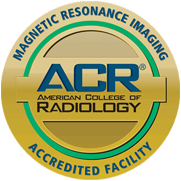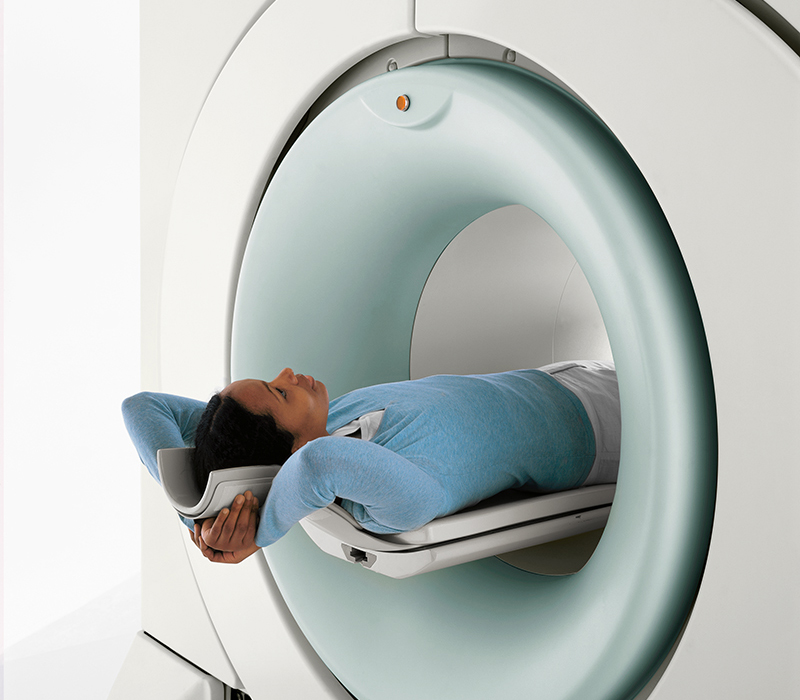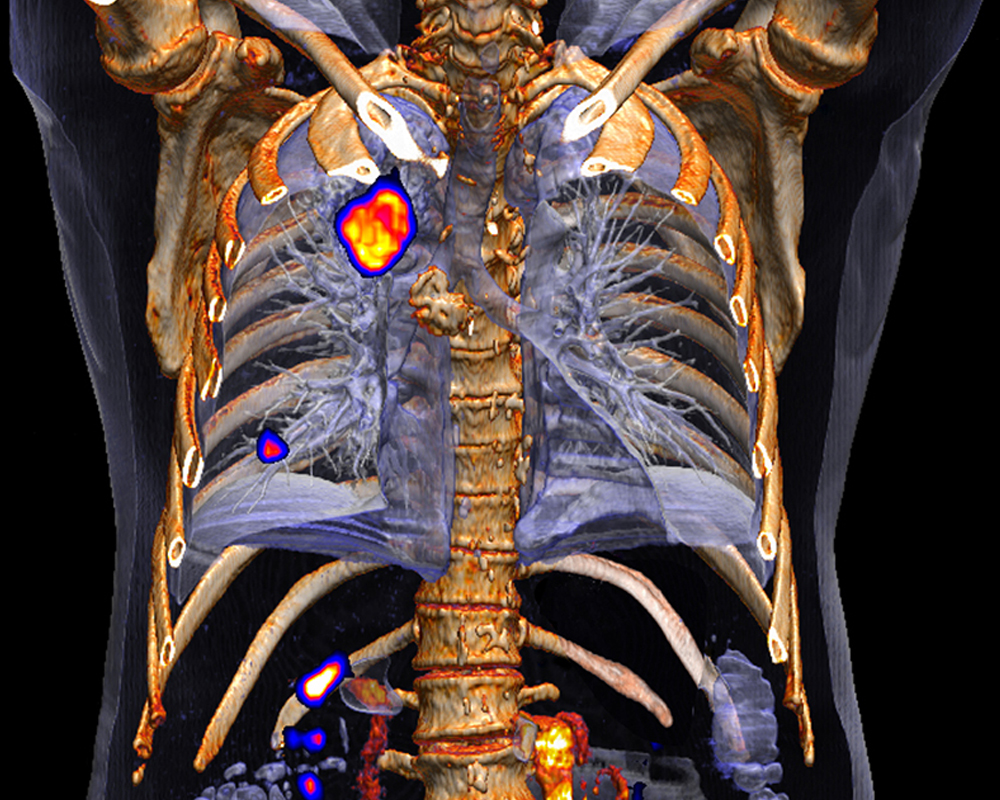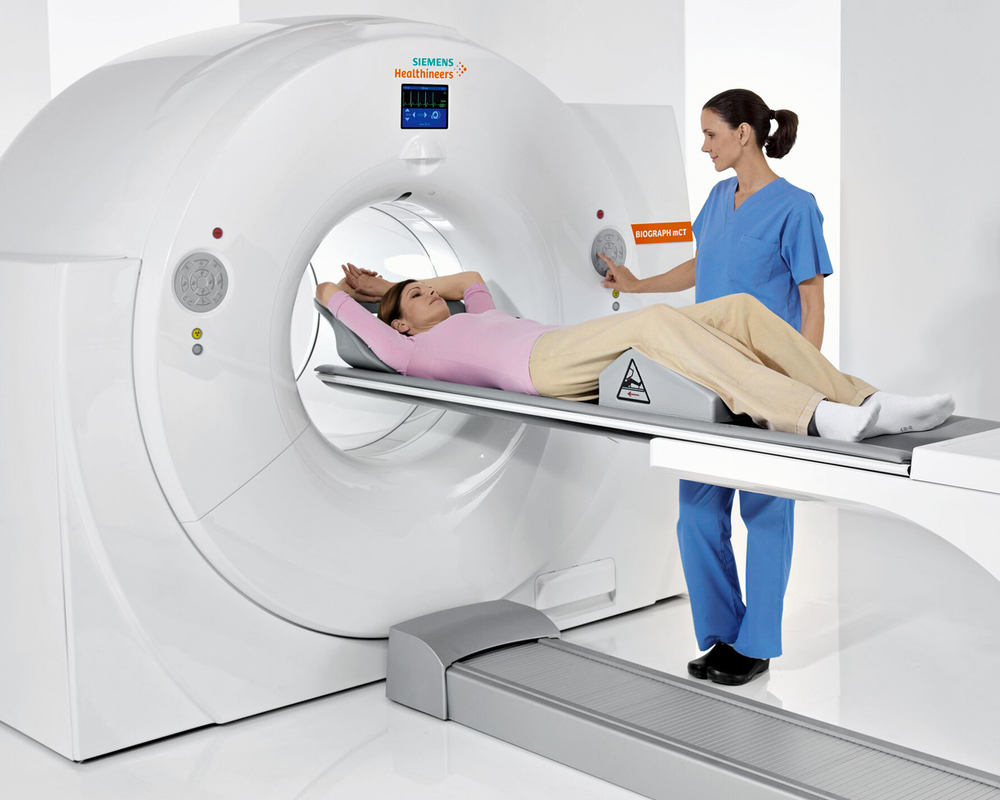PET/CT
A PET-CT scan combines a CT scan and a PET scan to give detailed information to more accurately diagnose and locate cancers while increasing patient comfort. The combined functions provide images that pinpoint the location of abnormal metabolic activity within the body, like malignant tumor cells. Combining the scans has been shown to provide more accurate diagnoses than the two scans performed separately.

How It Works
For the PET portion of either study, a small amount of radioactive material is injected into the body. The type of radioactive material depends on the exam. Once the injection is completed, the patient will wait about 60 minutes in a quiet area with limited movement while the body absorbs the material. More of the radiotracer material will accumulate in the cells with higher chemical activity, which generally corresponds to the areas of disease.
For the CT portion X-rays are taken from multiple angles as a patient is moved through the opening of the machine. An X-ray tube and high-resolution digital detector rotate very fast inside the machine’s opening to obtain pictures from all different angles and produce detailed images. The rotation of these parts is internal and cannot be detected by the patient. The images produced from a CT scan are significantly more detailed than a traditional X-ray.


Physicians utilize PET/CT scans for diagnosing, staging, and evaluating treatments for their cancer patients. PET imaging provides the physician with information that can characterize a questionable abnormality as malignant or benign. CT provides detailed information about the location, size, and shape of various lesions. In one continuous whole-body scan, PET/CT captures images of changes in the body's metabolism which are caused by actively growing cancer cells. PET/CT provides a detailed picture of the body's internal structures and reveals the size, shape, and exact location of any abnormal and cancerous growths.
Advantages of a PET/CT scan
Increased Patient Comfort
Better Data
Better Treatment Plans
How to Prepare
24 hours prior to the PET/CT scan
Refrain from any strenuous activity and do not eat or drink any caffeinated products (no coffee, tea, soda, chocolate, etc.), decaffeinated products, or juice. Eat a low carbohydrate diet (no bread, pasta, potatoes, rice, cereals, beans, or sweets). Chicken, fish, eggs, beef, cheese, bacon, and green vegetables are all okay to eat.
On the day of the PET/CT scan
You must not eat, drink, smoke, or chew for 6 hours prior to your exam time. Water and medications are okay.
Remove all jewelry and any other metallic objects such as metal zippers, body piercings, and removable dental work. Wearing comfortable clothing with no metal may prevent you from having to change into a gown.
Refrain from any strenuous activity and do not eat or drink any caffeinated products (no coffee, tea, soda, chocolate, etc.), decaffeinated products, or juice. Eat a low carbohydrate diet (no bread, pasta, potatoes, rice, cereals, beans, or sweets). Chicken, fish, eggs, beef, cheese, bacon, and green vegetables are all okay to eat.


During the Test
After reviewing your medical history, the nurse or technologist will place an intravenous needle/catheter into a vein in your arm or hand. Your blood sugar level will then be checked and the radioactive tracer will be administered through the I.V.
You will then be brought into the PET/CT room and asked to lie down on the scanning table. The scanning table you are lying on will be moved into the circular opening in the middle of the machine and the test will begin. The exam is non-invasive and the machine never touches you. Be sure to remain as still as possible to ensure the best possible images. The entire scanning portion of the exam takes about 20 to 30 minutes and your technologist will be able to talk to you from outside the room through an intercom.
Technicians looking at the scan results
Once all of the images have been recorded, the scanning table will move out of the PET/CT machine and the technologist will return to assist you off the table.
After the Test
Increase your fluid intake for the next 24 hours to help flush the radiopharmaceutical out of your system. Depending on the type of exam, you may be required to stop breastfeeding or limit your contact with pregnant women, small children, and pets.

 PET has been used for neurological imaging for many decades. It has grown in clinical importance, beyond its use in research, particularly due to patients with suspected dementia. Physicians can utilize PET imaging to visualize evidence of amyloid plaques when evaluating for Alzheimer's disease. PET/CT imaging can show precise areas of increased or decreased radiotracer uptake in the brain and doctors use this information to diagnose brain diseases, such as Alzheimer’s, dementia, and Epilepsy.
PET has been used for neurological imaging for many decades. It has grown in clinical importance, beyond its use in research, particularly due to patients with suspected dementia. Physicians can utilize PET imaging to visualize evidence of amyloid plaques when evaluating for Alzheimer's disease. PET/CT imaging can show precise areas of increased or decreased radiotracer uptake in the brain and doctors use this information to diagnose brain diseases, such as Alzheimer’s, dementia, and Epilepsy. PET/CT imaging of the heart allows the study and quantification of various aspects of heart tissue function. Dramatic advances in PET/CT scanners and specialized software have helped develop an important role for PET/CT imaging in cardiology for diagnosing patients, describing the disease, and developing a treatment strategy. PET/CT imaging provides a way to assess the severity of heart disease and measure its impact on heart function. Clinical studies show an important role for PET/CT in screening for coronary heart disease, assessing flow rates and flow reserves, and distinguishing viable from nonviable heart tissue.
PET/CT imaging of the heart allows the study and quantification of various aspects of heart tissue function. Dramatic advances in PET/CT scanners and specialized software have helped develop an important role for PET/CT imaging in cardiology for diagnosing patients, describing the disease, and developing a treatment strategy. PET/CT imaging provides a way to assess the severity of heart disease and measure its impact on heart function. Clinical studies show an important role for PET/CT in screening for coronary heart disease, assessing flow rates and flow reserves, and distinguishing viable from nonviable heart tissue.